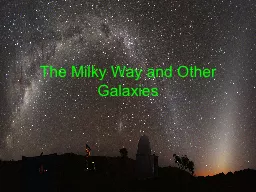PPT-Tour of the Milky Way
Author : pamella-moone | Published Date : 2017-12-03
Vital Statistics Its our home Contains more than 200 billion stars and a mass of 10 12 suns Its almost as old as the Universe itself 137 billion years old Structure
Presentation Embed Code
Download Presentation
Download Presentation The PPT/PDF document "Tour of the Milky Way" is the property of its rightful owner. Permission is granted to download and print the materials on this website for personal, non-commercial use only, and to display it on your personal computer provided you do not modify the materials and that you retain all copyright notices contained in the materials. By downloading content from our website, you accept the terms of this agreement.
Tour of the Milky Way: Transcript
Download Rules Of Document
"Tour of the Milky Way"The content belongs to its owner. You may download and print it for personal use, without modification, and keep all copyright notices. By downloading, you agree to these terms.
Related Documents














